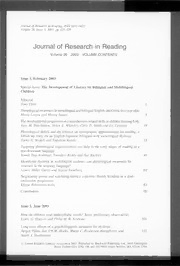
Journal of Research in Reading 2003: Vol 26 Table of Contents PDF
Preview Journal of Research in Reading 2003: Vol 26 Table of Contents
Journal of Research in Reading, ISSN 0141-0423 Volume 26, Issue 3, 2003, pp 325-328 Journal of Research in Reading Volume 26 2003 VOLUME CONTENTS Issue 1, February 2003 Special Issue: The Development of Literacy by Bilingual and Multilingual Children Editorial Tony Cline Phonological awareness in monolingual and bilingual English and Greek five-year-olds Maria Loizou and Morag Stuart The developmental progression of comprehension-related skills in children learning EAL Jane M. Hutchinson, Helen E. Whiteley, Chris D. Smith and Liz Connors Phonological deficit and the reliance on orthographic approximation for reading: a follow-up study on an English-Japanese bilingual with monolingual dyslexia Taeko N. Wydell and Tadahisa Kondo Targeting phonological representations can help in the early stages of reading in a non-dominant language Sonali Nag-Arulmani, Vasudevi Reddy and Sue Buckley Identifying dyslexia in multilingual students: can phonological awareness be assessed in the majority language? Louise Miller Guron and Ingvar Lundberg Negotiating power and redefining literacy expertise: Buddy Reading in a dual- immersion programme Eliane Rubinstein-Avila Contributors Issue 2, June 2003 How do children read multisyllabic words? Some preliminary observations Lynne G. Duncan and Philip H. K. Seymour Long-term effects of a psycholinguistic treatment for dyslexia Jurgen Tijms, Jan J.W.M. Hoeks, Marja C. Paulussen-Hoogeboom and Anton J. Smolenaars © United Kingdom Literacy Association 2003. Published by Blackwell Publishing Ltd., 9600 Garsington Road, Oxford OX4 2DQ, UK and 350 Main Street, Malden, MA 02148, USA VOLUME CONTENTS Aye, aye, aye, aye: orthography enhances rapid word reading in an exploratory study Graham F. Neuhaus and Yolanda Post Regularisation of nonwords in dyslexia: contributions of visual orthographic and phonological onsets Annaliese Caney and Francis Heritage Martin Serial naming speed and the component elements of speech time and pause time: relationships with the development of word-level reading in children aged four to five years Shirley Cobbold, Terri Passenger and Colin Terrell Reading strategy use and motivation among Chinese good and poor readers in Hong Kong Kit-ling Lau and David W. Chan The development of orthographic and phonological strategies for the decoding of words in children Frances Martin, Elizabeth Claydon, Adam Morton, Sonia Binns and Chris Pratt Book Reviews Contributors Issue 3, October 2003 The effects of rime- and phoneme-based teaching delivered by Learning Support assistants Robert Savage, Sue Carless and Morag Stuart A systematic review and meta-analysis of randomised controlled trials evaluating interventions in adult literacy and numeracy Carole J Torgerson, Jill Porthouse and Greg Brooks Inferencing skills of adolescent readers who are hearing impaired John Doran and Anne Anderson Computerised formative assessment of reading comprehension: field trials in the UK Keith J. Topping and Anna M. Fisher Flexible use of lexical and sublexical information in word recognition Greg Decker, Greg B. Simpson, Mark Yates and Lawrence Locker, Jr. Evidence for different parent-child strategies while reading Brett M. Stoltz and Janet E. Fischel Are all phonemic awareness tests created equally? A comparison of the Yopp-Singer and the task of auditory analysis skills (TASS) Jerry Wilde, Betty Goerss and Jennifer Wesler 295 ( United Kingdom Literacy Association 2003 VOLUME CONTENTS PASS cognitive processes, phonological processes, and basic reading performance for a sample of referred primary-grade children Laurice M. Joseph, Megan E. McCachran and Jack A. Naglieri Book Reviews Contributors
